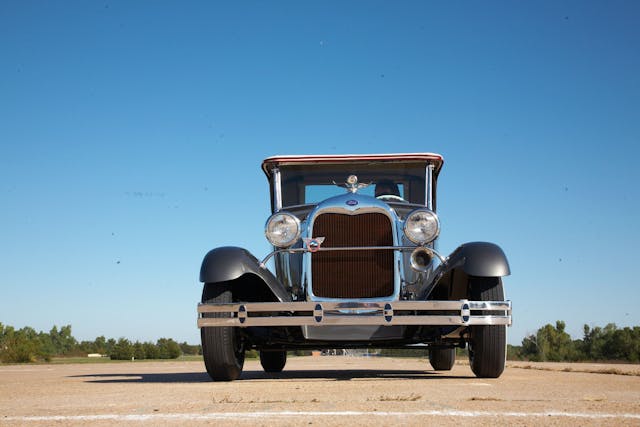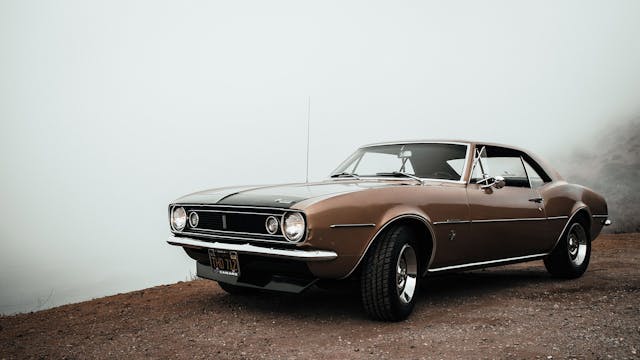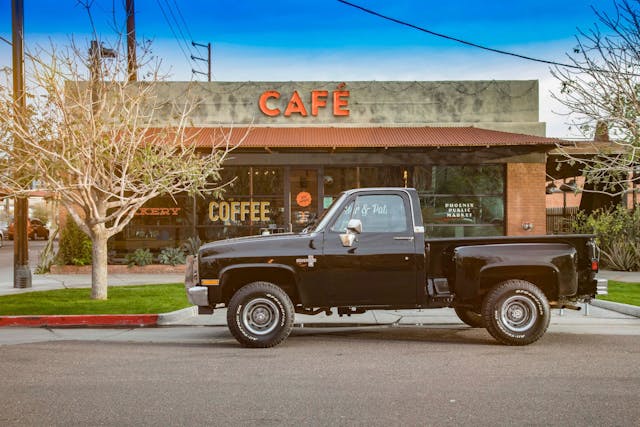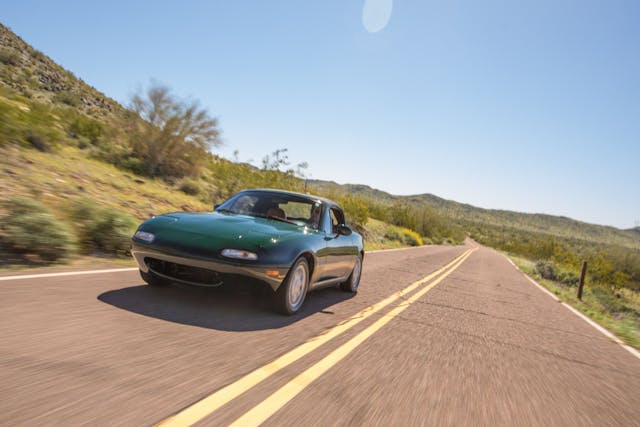Each generation’s favorite classic cars
Want to know something kids today can’t get enough of? Dogs. Especially really cute ones with sad eyes. Gen-Zers are also into—get this—hot drinks on cold days. Some like cilantro, but others hate it. Spend enough time on TikTok and you’ll get the sense that many teens—gosh, this is so weird—crave the approval and affection of others.
OK, I’ll stop. My point, in case all that wasn’t obvious enough, is that lots of people tend to be into lots of the same stuff, regardless of age. The ballyhooed “generation gap,” although grounded in certain realities of our fast-changing world, is largely a figment of marketers’ imagination.
Hagerty’s demographic data tell a similar story. When someone calls us about insurance on a particular car, we ask for basic details like their age. Since we get thousands upon thousands of these calls every year, we have a pretty solid sense of what enthusiasts in each age group are into. Turns out that whether the caller is 16 or 101 (actual ages of our youngest and oldest callers) there’s a really good chance they’re asking about a Chevrolet Corvette or Ford Mustang.
Of course, there are differences, and we’ll get into some of them below. In the interest of presenting a fuller picture, I’ve shown two metrics for each generation—first, the vehicles that age group calls about the most, and second, the cars for which it represents the highest percentage of interest. The latter metric helps us spot trends early on but it also, in isolation, can be very deceiving. For instance, looking solely at generational share, you’ll see that Gen-Z represents 44 percent of insurance quotes for the 1989–1994 Nissan Laurel. Woah! Before you start filling warehouses with the JDM sedans, though, perhaps I should tell you the raw total of calls that represents: 24. In contrast, some five thousand kiddos called us about Mustangs. (Note: In the interest of avoiding such misrepresentations, I have in the sections below excluded vehicles for which we received fewer than 100 calls from a particular age group.)
Read on to see what each generation craves, but don’t forget the key takeaway: What we share in common far outweighs what separates us.
Pre-baby boomer (1920–1945)

Most-called-about vehicle: 1928–1931 Ford Model A
Highest share of calls: 1950-1953 MG TD
These shouldn’t surprise anyone. Not only are both cars, um, old, but they’re also the two archetypes of the attainable classics favored by younger generations. In the Ford Model A, we have a passenger car that, due to its ubiquity, charisma, and association with a time and a place, found its way into enthusiasts’ hearts. The MG TD, meanwhile, was the sports car that made Americans love sports cars—every Corvette, Miata, and Boxster produced owes it a small debt.
On that note, we all owe a debt to these older collectors. They founded the car-collector hobby and, to a large extent, created car culture as we know it in this country. The greasers who popularized hot rodding, the tweed-wearing East Coasters who brought over British roadsters, our pantheon of American racing greats, including Phil Hill, Carroll Shelby, Dan Gurney, and Mario Andretti—all of them hail from the generation born before 1945, and all continue to resonate today.
This generation also continues to throw a lot of weight around the collector car market. Although its ranks, sadly, are thinning, pre-baby boomers are still more numerous in our insurance quote data than Gen-Zers, and they’re overrepresented among the most expensive vehicles.
Baby boomers (1946–1964)

Most called-about vehicle: 1972–1984 Chevrolet Corvette
Highest share of calls: 1969-1976 Triumph TR6
If you’re reading this article, based on our stats, you’re likely a baby boomer. For all the obsession with the growing youth contingent, baby boomers still represent the lion’s share of interest in cars: Nearly four out of every ten people who called Hagerty for a quote on insurance in the past year come from that generation. This is to a large extent a by-product of wealth—baby boomers control more than 50 percent of it in the United States, per the Federal Reserve—yet there’s no denying that the generation which came of age in the 1960s has a unique connection to the automobile.
When it comes to what these enthusiasts crave most, there’s no contest. It’s all about Corvette. The most-produced Vette, the 1972–1984 C3, naturally tops the list, but the C2, C4, and C5 all make the top ten.
What sets American baby boomer enthusiasts apart, however, is their fascination with British sports cars. The folks who grew up with The Beatles, the Rolling Stones, and The Who have a special relationship with the cars from that country. Four out of the ten cars for which Baby Boomers represent the highest share of insurance quotes are Brits, topped by the venerable Triumph TR6.
Generation-X (1965–1981)

Most called-about vehicle: 1967–1969 Chevrolet Camaro
Highest share of calls: 1983–1990 Land Rover Defender
Gen-Xers are, in the near term, the most important age group for classic car values. That may sound odd given that they are commonly thought to be America’s smallest generation, sandwiched between baby boomers and their millennial children. Yet in terms of wealth and disposable income, Gen-Xers punch well above their weight. Most of these forty- and fifty-somethings are in their peak earning years, and many are finally getting the kids off their dole. As a result, the cars for which this age group is over-represented are gaining in value. It’s no surprise then, that classic SUVs—the hottest segment of the collector car market right in recent years—dominate the list of vehicles Gen-Xers favor compared to other generations.
Conversely, though, it is Gen-Xers who really start to bust conventions of what enthusiasts of a particular age “should” like. Look at the vehicles they call about most, and you essentially see cars from the same era as the one prized by baby boomers. Topping the list is the 1967–69 Camaro, a car that even the oldest Gen-Xers likely don’t remember seeing new, and one that Baby Boomers also like a whole lot.
Millennials (1982–1996)

Most called-about vehicle: 1981-1987 Chevrolet C/K Series Pickup
Highest share of calls: 2002-2007 Mitsubishi Lancer/Evo
Time for some myth-busting. Millennials, the ones who grew up during the golden era of Japanese performance and were the core audience for the Fast and Furious films, are absolutely bonkers for American cars. The ten cars quoted most by this generation are all Fords and Chevys. Matter of fact, the Miata, the 3 Series, and the venerable Beetle are the only imports the crack Millennials top 25—otherwise, it’s wall-to-wall Detroit.
The list of cars quoted most exclusively by millennials probably hews closer to what you might expect—Evos, STis, Skylines. Yet here’s where the data can become deceptive. Remember that this young group of collectors, though it is growing by leaps and bounds, still represents a smaller slice of the pie than their elders. That means Gen-Xers and Baby Boomers tend to crowd them out, percentage-wise, on American classics. For instance, the most popular car for millennials’ by total quotes is the 1980s Chevy C/K. Yet millennials represent only a fifth of the interest in the truck. Meanwhile, the car for which millennials represent the biggest proportion of quotes, the 2002–2007 Evo, actually isn’t all that popular—only 153 millennials called us about them. In other words, a high percentage of millennial interest in a car usually tells us more about a lack of interest from older collectors.
That doesn’t mean those Japanese classics don’t have a bright future. We expect that as the numbers of millennial collectors swell, so too will interest in and values for cars they and they alone love. But make no mistake: the Vettes, Mustangs, and pickups currently hoarded by older generations will almost certainly remain more popular.
Gen-Z (1995–2012)

Most called-about vehicle: 1989–1997 Mazda Miata
Highest share of calls: 1988-1994 Nissan Silvia S13
To the extent that Gen-Z represents the exception here—the only generation that quotes a modern Japanese car more than any other—it also proves the rule. Because the car happens to be none other than the first-generation Miata, a modern Japanese car performing a spot-on impression of an older British roadster.
The vehicles Gen-Z quotes more than other generations is without a doubt the most eclectic grouping here. More so than for Millennials, the list seems to represent genuine interest from this age group rather than just apathy from older collectors. Note, for instance, that the Miata makes the cut here, as well. Dealers and auction companies who wish to be relevant a decade or two from now might start beefing up on their knowledge of the JDM heroes on this list. That said, they also should stay current on Corvettes and Mustangs because—you guessed it—the youngest set of collectors also loves those.
Check out the Hagerty Media homepage so you don’t miss a single story, or better yet, bookmark us.



You tagged me correctly. At 81+, whose first car was a 1930 Model A (which I regret not having kept), I applaud the idea of the article.
Paul, I am 82 and I still have my first car, a 1930 Model A purchased in 1954. I was 14.
The sweet spot in my heart Detroit.
Looks like the largest factor in every generation is the car’s production numbers, otherwise we wouldn’t be seeing so many Mustangs and Chevy 350’s in every category.
There is an extra data point I would like to see — income or net worth. Being a boomer and looking at the list, my primary interest is mid-year corvettes, having owned 3 of them. However, I’ve been priced out of the market and my income level (and conscience) doesn’t allow me to drive a $100,000+ car to Walmart. Side note: when I bought my 1965 Convertible fuelie, I paid $29,000. As such, years ago, I moved to lower-cost British sports cars which I can thrash, enjoy, and not have all the family savings wrapped up in a car. So, while my interest is mid-year corvettes, my insurance says “British”. 🙂
I question whether the population of people contacting Hagerty for insurance is representative of the car hobby. The heavy representation of Detroit iron in your results does not reflect the real world. Go to a Cars and Coffee event, at least in coastal areas, and take a look around if you don’t believe me.
Roger, I think as you on that matter.
“Roger,” Roger. Truer words than yours never appeared on these forums. Hagerty caters to the mainstream with press releases and auction hype of done-to-death cars, thrice-told tales, as they try to determine stated value amounts for their policies. They toss in the occasional historical article about interesting old cars now and then so the mainstream readers can imagine themselves “insiders.”
I fail to see how the number of quotes has anything to do with making it a generational favorite. I am a pre-boomer and my definite favorite is Porsche 356 4 cam speedster, however, you will never ever get a call from me for a quote. They hardly ever become available and are way above my means. On the other hand I might call if I ran across a 1960s Type 1 VW. Not a favorite, however a lot more available at a much more modest car. Favorites does not equate to available.
Yep.
I am surprised that while the “plastic bumper” C3 Corvettes made the top 10 list in every age group and the C2s were in the pre-boomer and boomer lists, the chrome bumper C3s did not make any of the lists. Many more of them were made than C2s and they are generally more affordable than C2s, yet they retain the classic look of chrome bumpers and the early ones still had high horsepower engines.
Note, however, that in a couple of places in the article the year range for the plastic bumper C3s is incorrectly stated as “1972-1984”, apparently getting the last digits of the years reversed. The year range is correct in the bar graphs as 1974-1982.
I’am a baby boomer I have a lot favorites but my favorite is the 62 Corvette maybe because I own one C1 forever
Struggling to understand the fascination my fellow boomers apparently have with the awfulness that’s the C3 Corvette. Bleah.
I had no expectations going into this read, but after looking at the data, I was a little surprised the 68-73 Corvette wasn’t high on the boomer and X lists, but the 74-82 was up there. Of course there’s fewer of the desirable 68-72 versions available, and they’re more $, but this surprised me nonetheless.
I’m a boomer. I miss my ‘65 TR4-A and my ‘69 Z28. Fortunately, I’ve held on to my ‘81 911SC which I bought new.
My first “car” was a VW Bus in 1981 when I was 18. I’m technically a Gen X, I guess just barely missing baby boomer status by just a few months. I became re-obsessed with Bus’s again in the last decade. My wife is a Millennial but is also very into Bus’s. With that said, my wife finally gave the go ahead and said stop looking at them lets just buy one. We also don’t have human children so it was an easier financial decision to make even though she makes more money then I do. Hegerty was great about insuring our Westy camper Bus. Our regular insurance company is a top rated company, Amica, who recommended Hagerty over themselves. Amica was double the price. I grew up with VW Bus’s and so did my generation. So this article is spot on.
What know interest at all in Porsche, Ferrari, Lamborghini, or Maserati, VERY STRANGE. Whenever I go to a cars and coffee those are more represented than anything on these lists.
You didn’t say, but I’m guessing that your cars & coffee events are somewhere on the Left Coast. Here in the Eastern Time Zone I have occasionally seen a Porsche and maybe once or twice a Ferrari, but I can not recall ever seeing either a Lamborghini, or Maserati. Perhaps a difference due to longitude? Mean average income? Or possibly what we grew up with? Whatever the reason it’s interesting to compare and speculate about the different likes and dislikes of different regions of the country.
Not even one Mopar.
I noticed that as well. A bit surprising being that as a group the MOPAR crowd is generally steadfast in the defense of their chosen ride and quick to point out the astronomical values assigned to the brand in. As a kid it was normal to choose your car brand loyalty – usually Chevy or Ford – and stand tall for for your pick.. Back then we would snicker at the ones that went down the MOPAR road – different story today.
Maybe the MOPAR folks prefer a different insurance carrier – just a thought.
I find the statistics on calls interesting but would much rather see a breakdown by cars actually owned and insured. We all have our fantasy cars (’70 Shelby GT500 Fastback) but what about reality?